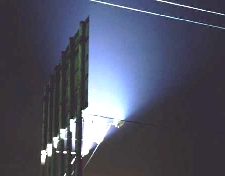 |
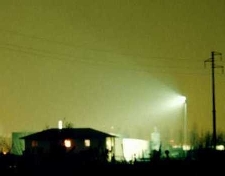 |
 |
| Fig.1 - Typical examples of unjustified dispersion of light upwards or where it is not required | ||
CIELOBUIO – Coordinamento per la protezione
del cielo notturno
presents:
CieloBuio
greatly acknowledges all those who collaborated to the realization of this document and
realated photos:
Bajoni Carlo, Benatti Roberto, Bonata Diego, Bonomi Ivan, Dalla Gassa Leopoldo, Di Sora
Mario, Duches Alberto, Falchi Fabio, Minuto Silvano, Rama Franco, Rossi Eric, Scannabissi
Andrea, Scardia Marco, Vedovato Marco.
For any information: CieloBuio – Coordinamento per la protezione del cielo notturno
info@cielobuio.org
The present technical provisions put into effect the directives of the regional law March 27th, 2000, no. 17, with which the Lombardy Region intended to confirm the ultimate objectives in theme of energy and environment: to rationalize and reduce the energy consumptions with wide breath initiatives which can stimulate the technological development, to reduce the light pollution on the regional territory and, as a consequence, to safeguard the ecological equilibria both inside and outside the protected natural areas and to protect the astronomical-, astrophysical- and scientific- observatories, as they are regional patrimony, to protect the activities of scientific research and divulgation.
The elaborated criteria, without detriment to the general determinations or claims more explicitly reported to the observatories, are oriented to the building of installations for the public and private outdoor lighting, characterized by illuminotechnical properties functional to control light pollution and to energy saving; for as it concerns the aspects connected to the plant engineering safety, please refer to the current directives in the field.
2. Fulfilments The Region
the georeferential data concerning the location of the observatory; a report on the typology of the observatory and on the relative instrumental equipment; the annual or pluriennal scientific- and cultural- program; the regulation for the access of the visitors and a report on the possible infrastructure to support them; the report on the historical activity done (for the observatories in activity, which apply for inclusion in the official list); color photos of environment, the landscape and the structure in his complex;
The Districts
[Violation Assesment Form R.L. 17/00]
[Violation Assesment Form R.L. 17/00]
The manufacturing-, importing-, supplier-companies
The designers
- the environment temperature during the measurement;
- the tension and the frequency of the power source;
- the reference rule used for the measurement;
- the identification of the laboratory which did the measure and the name of the technician in charge for;
- the specifications of the lamp (light source) used for the test;
- the position of the device during the measurement;
- the type of equipment used for the measure and the relative measure uncertainty;
- the declaration of the technician responsible for laboratory or of third corporations, i.e. IMQ, about the truthfulness of the measures.
[Example of product conformity declaration to the Lombardy Regional Law n ° 17 of March 27th, 2000]
The installers
[Installation declaration of conformity to the R.L. 17/00]3. Definition
The r.l. 17/2000 considers as light pollution of the atmosphere every artificial light irradiation that is dispersed outside the areas to which it is functionally dedicated and, in particular way, if oriented above the line of the horizon.
[Glossary of Basic Terms and Definitions to Lombardy Law] |
 |
 |
| Fig.1 - Typical examples of unjustified dispersion of light upwards or where it is not required | ||
From the date of coming into effect of the r.l. 17/00, all the new installations of outdoor lighting, both public and private, which concern the whole regional territory, including those still in design or in contract procedure, must be realized according to the present anti-light-pollution criteria and reduced energy consumption.
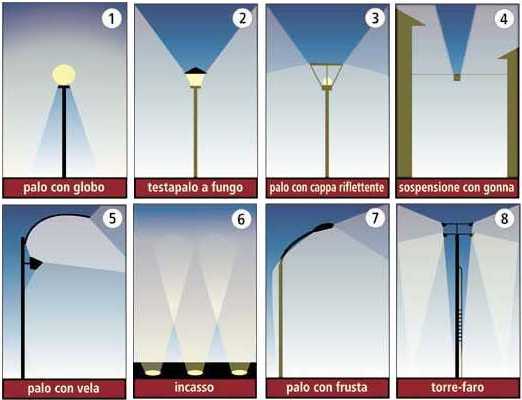 |
| Fig.2 - Lighting installations NOT admitted by the r. l. 17/00 |
 |
| Fig.3 -- Lighting installations corresponding to the r.l. 17/00 requirements. The lighting devices as from points 6 and 8 are admitted by the r.l. 17/00 art.6 paragraph 10 exclusively for structures of particular and proved historical importance only if it is not possible light up them from upward. |
All the specifications concerning outdoor lighting installations and devices, both public and private, must be corresponding to the r.l. 17/00 requirements and therefore, to the present criteria.
The installations already in phase of execution at the same date, must, if possible at once, be provided with systems and suitable precautions to avoid the light dispersion upwards, mantaining the obligation of their next adjustment according to the presents criteria.
For what concerns the
existing lighting installations not in accordance with the present criteria, the
normalization must be completed within 18 months from the coming into effect of the r.l.
17/00, without prejudice to the safety requirements of current directives, by modifying
the inclination of the devices to angles closer to the horizon line, when structurally
possible, and inserting suitable shields to limit the light emission beyond 90°, if
compatible with the requirements of electric safety.
[if this was not
at all possible, no further adjustments are provided for]
All the light sources present in the observatories protected areas, which are not in conformity with the present criteria, must, within four years from the coming into effect of the r.l. 17/00, be modified to reduce both light pollution and the energy consumption by the use of high- and low- pressure sodium lamps, or lamps with similar efficiency, in relation to the best available technology;
[In chapter 8 we further clarify the interventions of adjustment on the installations and the devices which must happen with the same timing (4 years)] 5. Common criteriaThe reduced energy consumption and anti-ligth pollution installations must own, simultaneously, the following qualifications:
 |
| Fig.4 - A few models of devices corresponding to the R.L. 17/00 requirements. In the CieloBuio site: http://www.cielobuio.org/cielobuio/products.htm it is possible to access a photographic guide of products having good impact on light pollution. The relevant producers agreed to their publication. (Attention: not all of the products in the site are fully corresponding to the R.L. 17/00). |
 |
| Fig.5 - Lighting devices commonly found in our towns not corresponding to the R.L. 17/00 requirements. |
Type of
Lamp
| Lumens per |
watt Average Lamp Life |
(Hours) Incandescent |
8 - 25 |
1000 - 2000 |
Mercury Vapor |
13 - 48 |
12000 - 24000+ |
Fluorescent |
60 - 110 |
10000 - 24000 |
Metal Halide |
60 - 100 |
10000 - 15000 |
High Pressure
Sodium |
45 - 110 |
12000 - 24000 |
Low Pressure
Sodium |
80 - 180 |
10000 - 18000 | |
| copyrighted (©) by the IDA | ||||||||||||||||||||
 |
| Fig.6 - Some of the aspects which can characterize the lighting devices configuration, necessary to satisfy the requirements of the L.R.17/00 |
6. Criteria for specific plants
- calculation of the luminance in function of the type and the colour of the surface;
- utilization, luminance being equal, of devices whit reduced electric power demand and optimum conditions of light points interdistance;
- maintenance of homogeneous luminance values on all the illuminated surfaces, not higher than 1 cd/m2, without prejudice to any safety disposition;
- use of devices able to reduce, within the hours 24.00, the light emission by at least 30% with respect to the full regimen of operativity, provided that safety is not compromised;
- choice of installations with greater utilization coefficient ;
- duly realization of installations, as indicated by the CEE Directives, National provisions and DIN, UNI, NF, etc. norms assuming, conditions being equal, the normative references which compete for the minimum level of maintained luminance.
For the following installations categories, the following criteria must be also applied, integrating what devised in Chapter 5.
Extra-urban installations |
| Fig.7- Floodlight installations on an extra-urban road (with cycle track), corresponding to the R.L. 17/00 requiremetnts and realized in Usmate after the approval of the R.L. 17/00 |
The lighting of motorways, highways, traffic circles, etc. must be guaranteed preferably employing low-pressure sodium lamps; if necessary, analogous high-pressure lamps are allowed.
 |
| Fig.8 - Left and right, two car parks corresponding to the R.L. 17/00 requirements; center, one with spheres partly screened, in any case not corresponding to the R.L. 17/00 requirements. |
 |
| Fig.9 - "obviously" polluting beacon-towers. In fact, in the last installations to the right, the upper cover has the only purpose to protect the lighting devices from bad weather. |
In the periods of not utilization, the lighting installations must be provided with suitable systems to switch them off or to reduce the luminance.
 |
| Fig.10 – Beacon-towers corresponding to the R.L. 17/00 requirements. |
In the installation of beacon-towers, the installed power must be lower than that of a plant with traditional devices, luminance of the surfaces lit up being equal, that is if the utilization factor exceeds the value of 0,5, reported to the only road surface.
Historical city-centers and commercial streetsThe lighting installations, in the presence of plantations, must be positioned so as to avoid that the flow towards the surfaces to be lit up is significantly intercepted by the canopy of the trees themselves.
The lighting of the old cities centres must give preference to devices positioned under eave or directly on the wall.
 |
| Fig.11 – Left:Dalmine City Hall Square. Lighting corresponding to the R.L. 17/00 requirements and light sources placed so as not to interfere with the trees canopy. Right:Two examples of lighting of old cities centres with devices under eave (in the image to far right a horizontal device put beside to an inclined one which instead disperses light upwards). |
The lighting of such plants, by beacons, beacon-towers and projectors, must be realized according to the general indications devised in Chapter 5.
 |
| Fig.12 - Sporting plants lightings corresponding to the R.L.17/00 requirements, with asymmetrical floodlights oriented horizontally and not dispersing light above the horizon. |
The same must be guaranteed with the use, preferably, of high-efficiency lamps; if it is necessary to guarantee a high chromatic yield, metal-halide lamps are allowed.
The installations must be equipped with suitable variators of the luminance in relation to the activities/events, i.e. trainings, competitions, televising and others.
The floodlights must be of the asymmetrical type, with such an inclination to restrain the dispersion of light beyond the area destined to the sporting activity.
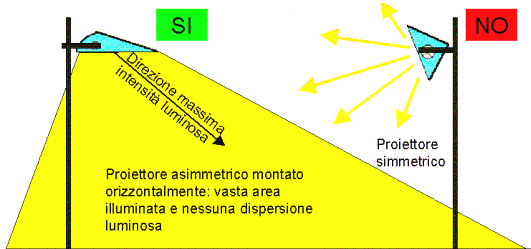
For the sporting plants of large dimensions, where televising is planned, it is agreed to use, further to the asymmetrical projectors, even narrow-beam projectors in any case equipped with shields or fins to avoid the dispersion of the light beyond the appointed areas.
In the lighting of the skiing tracks, the light dispersion beyond the same track must be strictly limited; the calculation of the luminance must be correlated to the high index of reflection of the snow. The installations must be turned off within the hours 21.
Monuments and buildingsThe lighting of such structures, mantaining the general indications of which to Chapter 5), must be, preferably, of grazing-, bottomwards type; only in cases of real impossibility and for subjects of particular and proven historical value, the beams of light can be differently oriented, remaining, any way, at least one meter under the upper edge of the surface to be illuminated and, in any case, within the perimeter of the same building or monument, arranging for the partial or total switching off, or for the decrease of absorbed power, within the hours twenty-four.
 |
| Fig.13 -Tthree different cases of building lighting. In the first photography on the left, a palace of historical value with mixed lighting, bottomwards and within the outline of the building (thus corresponding to the R.L.17/00 requirements), and topwards (not corresponding). In the second photography a building of none artistic, historical, military interest or used for the administration of the justice lit up topwards with high installed power without any reason. In the third photography, the lighting of the building of high historical and artistic value, is done topwards keeping the light within the outline of the building as itself as specified by the R.L. 17/00, but with an excessive installed power any way. |
The installations must use optic able to collimate or shape the light beam (i.e. using spot projectors) and be equipped with possible shields to avoid or limit the light dispersion.
The mantained average luminance must not exceed that of the surfaces lit up in the surrounding areas, such as roads, buildings or other and, in any case, be contained within the mean value of 1 cd/m2.
The lighting of the industrial sheds must be made using preferably low-pressure sodium lamps.
 |
| Fig.14 - The figures show some devices for road , car parks and industrial sheds lighting. The lamps used are full cut-off, low-pressure sodium equipped with horizontal flat glass |
In the illumination of buildings without any historical value, high-efficiency lamps, such as high-pressure- or low-pressure sodium lamps are to be preferred; in alternative, also installations equipped with movement sensors for the switch on can be used. Control devices for the partial or total switching off, or for the decrease of used power within the hours twenty-four, must be taken into consideration.
Signboards without its own lightingThe lighting must be realized top-down, as defined in Chapter 5, "Common criteria".
Also the signboards with external sources of light belong to this category.
 |
| Fig.15 - Three manners to light up the signboards. In the first (side lighting - photography on the left) lightening topwards is avoided, but still half of the light it is however dispersed towards the upper direction. In the second, even if the lamps are screened by the protective shell (partially visible) part of the light goes out beyond the upper edge of the road panel. And at last the third installation is undoubtely a correctly illuminated business signboard, according to the R.L. 17/00 requirements (overhead lighting) |
8. Additional directives for the protected zones
The installations included in such territories, keeping in mind the general dispositions for the adjustment of the existing ones at the date of coming into effect of the law 17/00 and already shown in Chapter 4, and the qualifications of which to Chapter 5, must also conform to the following supplementary criteria:
[In this chapter are clarified the types of interventions to be done on installations and devices with the same timings shown in Chapter 4 (4 years), except where differently stated] |
| Fig.16 - Devices shielded according to the directives for the protected zones. These are devices normally considered NOT conform (prismatic cups and inclined projectors) - Courtesy: International DarkSky Association |
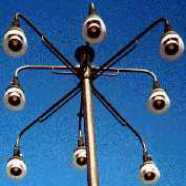
 |
| Fig.17 - A simple shield to avoid undesired light and directed towards the sky. In the above image, an example of adjustment to the.R.L. 17/00 requirements performed at the Railway Central Station of Milan: an aluminium cup has been inserted between the bulb and the protective opal glass to avoid light dispersion. |
Exemption to the present criteria is granted for:
 |
| Fig.18 - Four examples of internal lights: inside buildings, under arcades and in tunnels (pedestrian or road) |
 |
| Fig.19 - In the two photos on the left, the lighting is in accordance with the exemption for 3 not shielded light points of max 23 W fluorescence lamps. In the right image however the exemption may be granted only if the 5 devices (light points) were each equipped with max 23 W fluorescence shielded lamps (thing which does not happen) so that the maximum emission at 90° and beyond does not altogether exceed 2250 lumen |
- the business signboards, as indicated in art. 23 of the "New Code of the Road" and related Accomplishment Regulations, and those with surfaces not larger than 6 squared meters, in any case with top-down light flow, in order to get the light intensity within the terms of Chapter 5;
Fig.20 - On the right a business signboard which does not need neither a specific project nor the authorization of the Mayor, even if its conformity to the technical prescriptions (0 cd/klm at 90° and beyond) must be verified. In this case the inclination, not very conform to the R.L. 17/00, could be compensated by the shielding effect of the terrace. In the left image, another type of signboard (corresponding to the R.L. 17/00 requirements, since it is correctly illuminated) that requires a specific project and the authorization of the Mayor, being larger than 6 squared meters.
- all the devices of shop windows external lighting, for a number not higher than three shop windows, with light flow in any case directed top-down, in order to get the light intensity within the terms of Chapter 5;
Fig.21 - Left: a shop window incorrectly lit up from the bottom to the top. Right: the lighting is corresponding to the R.L. 17/00 requirements. If the right shop window was truly conform, it would not need neither a project nor authorization by the competent authority
 |
| Fig.22 - A few types of signboards exempted by the law and for which the law requires, but only in the protected zones, only the switching off after 23.00 hours or at the time of closing of the exercise. It is possible to see: boxed letters with their own lighting (the cinema inscription), uncovered neons (entry decoration at the cinema and inscription in Chinese), or panels with internal lighting (the inscriptions restaurant and the playbill of the cinema). |
 |
| Fig.23 - A few
types of advertising lightings. Upper left: Christmas illuminations. Such signboards of temporary use (very limited in time) can be installed since expempted by the R.L. 17/00. Upper right: Carabinieri’s signborard in exemption by the law as pertaining to a structure in which public order is practised (exempted also for the switching off as from art.8, letter h) of the present regulations). Lower left: Interesting lighting totally shielded and with low lighting values, more than sufficient for the purpose it is intended for. Lower right: business signboard in exemption by the law since of the kind not illuminated from the exterior; however, this kind of signboard must be shut off if in the protected areas around observatories, according to art.8, letter h) of the present regulations) |
The revocation of the above exemptions, inside the protected zones, results from specific indications agreed upon between the interested municipalities and the observatories.
To get the authorization of which to the art. 4, comma 1 – letter b) of the r.l. 17/00, the exemption as from letter d) is limited only to the design.
In any case, all the signboards must be switched off, as indicated in Chapter 8, letter h).
 |
| Fig.24 - Lighting (by night and during the day) of flowerbeds and gardens with installations corresponding to the R.L.17/00 and related Accomplishment Regulations |
It is forbidden on the whole territory of the Lombardy Region the use rotating or fixed beam-lights or beacons of whichever type, for the mere advertising aim.
 |
| Fig.25 - Fixed or rotating advertising beam-lights. Such types of lighting are absolutely forbidden on all the regional territory. In the same way, any other types of advertising light calls not belonging to the signboard category as analysed in the exemptions of Chapter 9, such as illuminated montgolfiers or airships, light inscriptions projected in sky or the like, are absolutely forbidden too. |